John Hall and Company’s Hoke Smith started the first weekend of deer season in Alabama, scoring a trophy whitetail buck in Elmore County. On top of that, Hoke’s sister got her first buck archery hunting.
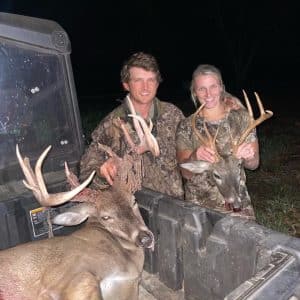
Hoke’s sister harvested her first archery deer!
We asked Hoke a few questions.
When did you start deer hunting?
I was born into an outdoorsy family. My dad was a big wing shooter. My mother was raised on a farm in south Alabama. Dad started taking me to the hunting camp to spend weekends with all my cousins around the age of 5. I killed my first deer when I was 8. I’ve always enjoyed the hunting camp atmosphere, spending time with the people I love, and quality time with friends and family.
Hunting was our reason for spending the weekends in the woods. It is a lifestyle. And it is one of the things I enjoy doing the most.
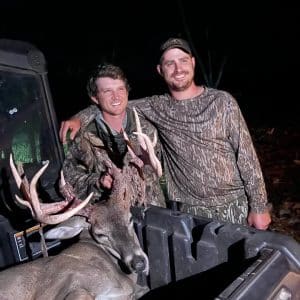
Hoke’s best friend helped him find and bring in the deer.
How do you prepare for whitetail deer hunting season?
That answer can change from year to year, but it’s typically a year-round thought process. I’m always thinking of the seasons to come during the ongoing season. There can be a never-ending list of projects I want to get completed. However, what gets done in preparation for the season vs. what actually gets finished is two different things.
Preparation for hunting season can be intense, or it can be simple.
We do the typical planting of food plots, prescribed fires, etc. Some people go all out and spend tons of money feeding the wildlife year round, planting summer food plots, so on and so forth, dreaming of a trophy buck. I typically take the simple route because I don’t want hunting whitetail deer to be a job.
It may not be the best preparation route, but I like to tell myself a low-pressure, natural, and native habitat is what wildlife prefers. So, sometimes, preparing for hunting season can be as simple as scouting, hanging a stand, and hunting.
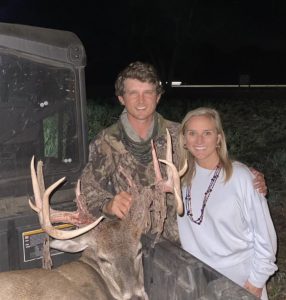
Hoke with his wife.
What did you think when you first saw the trophy buck?
I put a few trail cameras out in mid-August to see what kind of deer were hanging around. Pleasantly, and to my surprise, this fellow had been calling the property home! I tried not to get my hopes up because I figured he would leave and change his home area as fall approached.
As the season started, I told my wife I had never been so nervous to go deer hunting. I had so many negative “What if” thoughts running through my mind.
“What if the neighbor gets him.”
“What if I make a bad shot or spook him.”
After spending a few hours in the stand and not seeing anything the afternoon of the hunt, my confidence was diminishing. I saw a small buck that I knew was familiar. My mentality switched, and it was game time. I got ready, thinking the chances were high that he could be with the small buck.
Sure enough, in the next few seconds, I saw A LOT of antler coming through the woods!
Excitement, nervousness, shaking, heavy breathing, and all the symptoms of what deer hunters call “Buck Fever” officially kicked in. As he cautiously made his way into bow range, I unintentionally calmed myself down and became more nervous about not screwing up this opportunity.
The buck finally committed and presented a perfect 25-yard broadside shot, and at that point, my almost 20 years of bow hunting experience kicked in like instinct.
Wham, Bam, Thank you Mam!
I immediately called my best friend, who was hunting a few hundred yards away, and my wife!
When my buddy “Gator” arrived, we began tracking the deer. He ran further, and the recovery took slightly longer than expected. By the time we recovered the deer, my wife, daughter, sister, brother-in-law, niece, and best friend were all there to celebrate the recovery of this deer!
It was a memorable evening and one that I won’t ever forget. I will continue to pursue these animals season after season, but having a moment like that and harvesting a deer like this will be hard to come by!

Hoke continues the family hunting legacy with his daughter.
What are your favorite counties in Alabama to hunt?
I have been fortunate to hunt at different places all across the state. Most counties have diverse landscapes and habitats just within themselves. It is hard to pick a single county that is my favorite. I may be biased because it is close to home, but Montgomery, Lowndes, and Bullock are hard to beat. I love the diverse properties with open land, hardwoods, creek bottoms, and rolling topography. It creates great habitat and diversity for wildlife of all kinds. Whitetail deer populations are strong, and you never know when you may come across a trophy buck!
Here are a few tips for new deer hunters on our blog- Click HERE.
Current properties ready for hunting-

Are you gearing up for a successful deer hunting season in 2023? We’ve compiled a list of valuable deer hunting tips to help you maximize your chances of a fruitful hunt. Whether you’re a seasoned hunter or just starting, these strategies can make a significant difference in your success rate.
Scout Your Hunting Area Early
When it comes to successful deer hunting, it’s essential to start scouting your hunting area well before the season begins. Look for deer hunting tips such as tracks, trails, droppings, and rubs as signs of deer activity. To gain more insights, utilize trail cameras to monitor deer movement patterns.
Understand the Rut
To maximize your chances of success, it’s crucial to understand the rut, also known as the mating season, in your region. This knowledge can significantly impact deer behavior. Bucks are more active and visible during this period, making it a prime time for hunting. This deer hunting tip can help you plan your hunts effectively.
Choose the Right Stand Locations
Selecting the right stand locations is critical to a successful hunt. Set up your tree stands or ground blinds in areas that offer excellent visibility and are positioned downwind from where you anticipate deer to approach. Pay close attention to prevailing wind directions, another valuable deer hunting tip.

Scent Control Is Important Deer Hunting Advice
Effective scent control is crucial in avoiding detection by deer. Use specialized scent-control products and techniques to minimize your human odor. This includes wearing scent-free clothing, using scent-eliminating sprays, and even showering with scent-free soap before heading out on your deer hunting excursion.
Practice Stealth
Achieving a quiet and stealthy approach is essential for a successful deer hunt. When entering and exiting your hunting area, move quietly and deliberately. Avoid creating unnecessary noise that could startle deer.
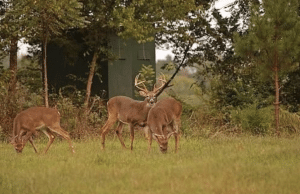
Learn Deer Patterns
Understanding the deer’s seasonal movement patterns is fundamental. Deer are often most active during the early morning and late evening, specifically at dawn and dusk. This deer hunting tip can help you time your hunts effectively. Learn more about deer hunting in Alabama at Outdoor Alabama HERE.
Use Calls and Scents Sparingly
When using deer calls and scents, remember that less is often more. Use these tools strategically and sparingly to avoid overwhelming the deer.

The Top Deer Hunting Tip Is To Be Patient
Deer hunting often requires a great deal of patience. There will be times when you need to sit for hours without any action. Stay focused and patient, and be ready to seize the right opportunity.
These deer hunting tips can guide you to a successful hunting season in 2023. Always prioritize safety, ethical hunting practices, and continue learning from your experiences to improve your skills as a hunter.
Read more blog articles… Learn the top 10 priorities when buying hunting land HERE. Or, read our series of interviews with Alabama’s Jim Main on wildlife and forest management HERE.
Learn more about John Hall and Company HERE.
Jim’s Alabama land legacy is a testament to the enduring bond between a landowner and his cherished property. His journey is interwoven with memorable events, remarkable friendships, and a steadfast commitment to preserving Alabama’s natural beauty for generations to come. I thoroughly enjoyed my time with my friend Jim Main. This is the conclusion of our interview and perhaps my favorite part. Enjoy.
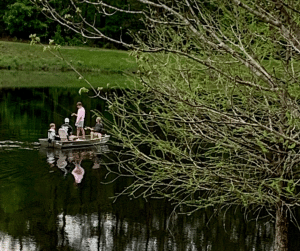
An Alabama Land Legacy of Memories
John: What’s a memorable story that comes to mind?
Jim: You know, if I shared one about one of my children or grandchildren, the others might get their feelings hurt. Here’s a story that won’t hurt anyone’s feelings. Some years ago, during hunting season, I had about 30 or 40 of my friends over for a barbecue. I hired a band from North Carolina to perform.
They wanted to go hunting, and I agreed to let them hunt if they would also do a concert and a gospel performance for my mama at the Baptist Church. The band came and performed as if they were a famous group. I had also invited the Governor of Alabama, who loved to sing. During the band performance, the Governor decided to join the band on stage.
However, since the band was from out of state, they had no idea he was the governor. He stepped up on the porch stage, grabbed the microphone, and started singing. Immediately, the lead singer took the microphone away from him and said, “Buddy, we don’t need your help. Go back and sit down.”
The crowd erupted in laughter, and it didn’t stop for the next two songs.
John: Now you’re good friends with two governors and have worked with two others. Can you tell us which governor took the stage?
Jim: He wouldn’t mind. I’ll say this much: He was a non-drinker who liked to sing.
It did embarrass him, and his security detail nearly fell on the floor laughing.
John: That’s a great memory!

A Friend and Family Share Their Land Legacy Wisdom
Jim: Also, Chief Justice of the Supreme Court, Bo Torbert, was a great friend of mine. He had a place near our property.
Bo was enthusiastic about the farm because of his knowledge of hardwood trees. He walked around the property and identified all the trees in the front and backyard around the cabin. Amazingly, every hardwood tree indigenous to this state area could be found in either the front or backyard.
He also bought me a book that helped identify trees based on their leaves, fruits, nuts, and bark.
John: Speaking of hardwoods, you should consider having your granddaughter create a scrapbook with the leaves taped in and labeled with the tree names. It would be a beautiful collection of leaves from the hardwoods on your property, and she seems interested in forestry.
Jim: My granddaughter, who is legally blind, is working for the Alabama Forestry Commission this summer. They’ve taught her about pine beetles, how to measure tree growth, how to plot areas, measure them over five years, and then come back to measure again.
Consequently, we acquired two other properties in 2017, and we’ve begun the necessary work on those. One of her summer projects as an intern with the Alabama Forestry Commission is to develop a management plan for the two new properties.
Jim’s Alabama Land Legacy to Future Generations
John: That’s impressive. I can tell you’re proud of your grandchildren. How do you feel about continuing the family tradition and allowing your children and grandchildren to own the farm in the future?
Jim: My children or grandchildren will not have the option to sell the farm. I don’t want them to argue over it. The farm will be placed in a trust that can’t be terminated until 70 years after my youngest grandson’s passing. When any disagreements arise, I’ll have been gone for a long time. Furthermore, my youngest grandchild is only 11.
John: Being a lawyer, I’m sure you researched the best way to handle the trust.
Jim: I set aside money in the trust to cover taxes, insurance, and minimal upkeep. Additionally, every time they harvest timber, they must replenish it to the original amount before distributing any money.
John: What a wonderful way to leave your land legacy for future generations to enjoy and financially benefit from for generations.

Wisdom to Create Your Own Land Legacy
John: What advice would you give to a new landowner?
Jim: This is what I would recommend.
1. Create a Plan
Create it and follow it. In other words, don’t try to do everything at one time. Brian Agnew at Alabama Forestry developed a 10-year plan for my timberland. The plan was meant to be completed in yearly increments, but I was impatient and did it all in the first year.
After 12 years, I had 500 acres of trees ready for harvest, but the cost of harvesting so many trees at once was a problem. In one year, I had an overwhelming income. For someone starting out, staging your processes and harvesting periodically could lead to a consistent income over a 50-year period.
So, get a plan from someone like your forestry expert on the John Hall and Company team and stick to it.
2. Tour Other Properties
Visit other landowners and learn from them. Often, I spent time with my friend Jerry Kaiser, who experimented with various techniques, and I learned from his experiences. Generally, I spend time with friends who own properties around Union Springs and learn from them.
3. Make Use of Resources
Use available resources. The Alabama Wildlife Federation has a helpful book called “Managing Wildlife” that offers guidance on planting different summer and winter food plots for ducks, turkeys, quail, and deer. Another recommendation is the Alabama Wildlife Federation, which has two wildlife biologists on staff who can provide a free wildlife plan.
In addition, the Alabama Forestry Commission offers free advice on managing timber, and the Alabama Extension Service provides a wealth of resources for land and wildlife management.
Furthermore, all these resources are invaluable. I encourage new landowners to keep learning and experimenting. Landownership is a wonderful journey for yourself and those with you who share your land legacy.
Conclusion
John: Thank you so much for taking the time to talk with us and for sharing your experiences and insights. We greatly value having a satisfied customer like you at John Hall Company. I can’t thank you enough for allowing us to help you find your property and for your referrals over the years. Your support is immensely appreciated.
(I could not find Jim’s book online for sale. I would like to add that here.)
The John Hall and Company’s “Best of 2023 BuckMasters Expo” picks, curated by Pete Hall, are here. Our time at the 2023 BuckMasters Expo in Montgomery, held at The Renaissance Convention Center, was so much fun. Moreover, we had insightful conversations with Alabama’s deer hunters at the John Hall and Company booth.
In addition, we visited with some of our favorite vendors. Check out our “Best of 2023 BuckMasters Expo”!

Bennett’s has a great selection at the 2023 BuckMasters Expo. Mike Bennett founded Bennett’s Archery in 1992. After his 24-year service in the United States Air Force, Mike created a store for archery enthusiasts. The shop offers a 20-target outdoor 3D range. In addition, there is an indoor facility for bow sighting and practice. Mike’s passion for archery is reflected in his over 30 years of shooting bows and 25 years of teaching archery. Together with his son Travis and their staff, they share their love for archery. Obviously, they provide customers with the best products and services backed by their experiences. This team is a wonderful resource for beginners seeking expert guidance. In addition, they provide the best insights to experienced archers looking for top-notch equipment.

We love shopping American Stutter every year at the BuckMasters Expo.
American Strutter is rooted in the traditional values that underpin the very fabric of our nation. At its core, this company exalts our Savior, Jesus Christ. Furthermore, it aligns with the conviction that our country was founded as ‘One Nation Under God.’ This allegiance to faith stands as the foundation for any accomplishments. Their inception was driven by a profound passion for hunting—particularly their love for the magnificent wild turkey—an emblem of nature’s brilliance.
American Strutter’s vision is steeped in the grandeur of a Tom strutting across the landscape. Markedly, they craft clothing that reflects style and confidence. And bridge the gap between hunting clothing and everyday fashion, from their T-shirts to Turkey Calls.
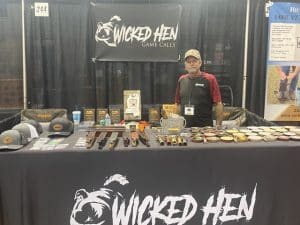
This is always a fan-favorite product at BuckMasters Expo.
Wicked Hen Game Calls has made a name for itself. They are based in Columbus, GA. Wicked Hen takes pride in their beautiful designs. With a commitment to excellence, their calls are meticulously crafted to capture the essence of real turkeys. The effectiveness of their calls in the field is a testament to their expertise. Hunters can rely on their products to lure in wary toms.

These guys are always great to talk to at BuckMaster Expo about current policies and regulations.
Silencer Central stands out for its commitment to making a meaningful difference. They empower their customers with accurate information through in-depth legal expertise gained from engaging with ATF compliance and collaborating with legal professionals. With a proven track record and unwavering credibility, Silencer Central is dedicated to supporting outdoor enthusiasts and upholding the right to bear arms. They put every customer at the forefront of their mission.
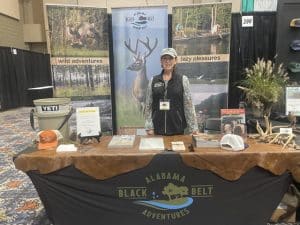
Always a first stop at BuckMasters Expo to learn about current information and hunting in the Black Belt.
The Alabama Blackbelt Adventures Association (ALBBAA) is a non-profit organization that champions outdoor recreation and tourism across the 23-county Blackbelt region, from Mississippi to Georgia. Central to their mission is recognizing the Blackbelt’s acclaimed hunting and fishing prospects.
This area contributes a staggering $1.1 billion annually to the economy and supports nearly 25,000 jobs, according to a 2019 study. B.A.S.S. founder Ray Scott and Buckmasters founder Jackie Bushman, have rallied behind the region, declaring it a “hunters’ paradise” and a hub for world-class fishing. In addition to hunting and fishing, the Blackbelt offers activities like canoeing, horseback riding, hiking, whitewater rafting, and birdwatching.
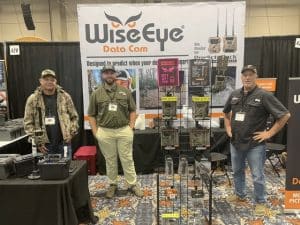
Loved seeing this new technology at BuckMasters Expo. Very impressive!
Wise Eye Data Cam stands out for their exceptional clarity in capturing photos and enabling easy identification of target bucks. These cameras go beyond visuals, capturing crucial data such as moon phase, temperature, wind direction, wind speed, and barometric pressure. This information allows hunters to cross-reference sightings of target bucks with precise data, forming the basis for predicting buck movement. Integrating their “PredictaBuck™” software further enhances this predictive capability, making WiseEye Data Cams a tool that captures moments and empowers hunters with valuable insights for a more strategic and successful hunting experience.

It was great meeting the 1819 staff at the BuckMasters Expo.
1819 News is a non-profit LLC that takes its name from the year of Alabama’s founding – 1819. They deliver news from across the State of Alabama. Aligned with the state’s resolute motto, “We Dare Defend Our Rights,” 1819 News is committed to providing news with unwavering integrity and aligning with the values that define Alabama. The team at 1819 News brings forward stories that encapsulate the essence of the state and its people.
In conclusion, there were so many great vendors at 2023 BuckMasters Expo. These are just a few of our favorites this year. We hope to see you all next year!
The John Hall and Company team is here year-round to help you with your land-buying or selling needs. We have a 30-year network and a legacy of selling land in Alabama.
Shop our recreational lands for your 2023 hunting season, or call me, Pete Hall, directly at 334.312.7099 to learn more about our services or listings.
Step into the world of Alabama Land Management “Part 2” of my interview with Jim Main. In this insightful interview, my friend Jim and I explore the nuances of effective land management practices, stewardship, and conservation.

Wildlife and Land Management in Alabama
John: Let’s dive into the topic of wildlife and land management and start with deer management. We have an excess of does on our family property. This has been the case for the past several years. We’ve encountered a unique challenge with a couple of hundred acres we leased to a cotton farmer. Deer have been nibbling on the cotton stalk at its tender stage, around four to six inches tall. Unfortunately, this has significantly impacted the farmer’s cotton crop, leading to financial losses over the past few years.
Consequently, we’ve implemented a deer management program that requires us to harvest a certain number of does annually. Additionally, we’re facing a wild hog issue, for which we’ve obtained permits to control the population by shooting them at night, except during deer season.
Upon touring your property, I didn’t notice a severe hog problem. I’m curious about your land management practices and whether you’re contending with an excessive deer and hog population.
Jim: For the initial 15 to 20 years, we focused on harvesting a specific number of does each year. We maintain a sign-in book that logs the areas where you intend to go hunting. In particular, you’re required not only to sign out but also to document your observations.
During hunting season, you’ll likely encounter the same deer repeatedly. However, the data collected consistently reflects the health of our doe herd. There are two large neighboring plantations across from me, totaling around 25,000 acres.
I eventually stopped the practice of data collection as those surrounding lands weren’t contributing to deer harvesting efforts. It became evident that our management efforts were in vain. Over the years, maintaining a consistent number of hunters and hunting days has led to a stable doe herd.
Hog Issues
As for feral hogs, our game cameras capture their movement across the property. Land management is essential in controlling the wild hog population. In the low areas, we try to keep the underbrush controlled to discourage hog activity while maintaining the upland-thinned pine areas. Hogs tend to avoid open spaces. Given your substantial creek, you might face a distinct challenge, as hogs tend to travel along the creek.

Wild Quail and Conservation Efforts
John: Your region seems to boast a healthy quail population.
Jim: Indeed, we have a population of wild quail. Around 15 years ago, we created a 35-acre “put and take” area for quail. It’s the sole place we hunt quail.
We enjoy the wild quail on our property. I was sitting on the porch at the farm with my wife and dog the other day when the quail started bob whiting. Gale would whistle back to the quail. The dog would bark whenever the quail whistled back at her, but when she whistled, the dog would not bark.
There was an entertaining show going on between Gale, the dogs, and the quail.
John: Your quail population is impressive, considering wild quail populations are diminishing. Regrettably, we don’t have any wild quail on our property, and it’s disappointing for us as we’re fond of quail hunting. We partake in “put and take” practices, releasing birds for hunting, which is enjoyable. Nonetheless, it doesn’t compare to the past, when we could find 15 to 20 coveys daily. Those days are long gone, especially since the 1960s. The decline in quail populations is disheartening.
Moving on to land management, your fish ponds are remarkable. However, it’s essential to maintain a balanced fish population by fishing 30 pounds of bass per acre annually. How do you manage that process?
Jim: We collaborate with a fish company that fertilizes and maintains our ponds. There are three ponds: a 15-acre bass and bluegill pond, a smaller catfish pond, and a five-acre “trash” pond. We refer to the latter as the trash pond because we don’t actively manage it. It hasn’t been fertilized or stocked, except for the occasional fish transfer from other ponds. The farm workers enjoy fishing in the trash pond, as it harbors the largest fish. Our fish management team might not endorse this approach.

Alabama Land Management of a Duck Project
John: Can you elaborate on your duck project?
Jim: When we acquired the property, it included a 35-acre duck project initiated with federal funding by the previous owners. The project mandates maintaining it as a duck project for ten years due to Federal commitments. It’s a truly distinctive feature of the property.
John: Your duck pond is remarkable. I understand you drain and plant duck food, flooding it during the winter. Despite not being on the flyway, you attract a substantial duck population.
Jim: We primarily attract wood ducks and occasionally other ducks. Over the years, cold fronts have pushed ducks our way, resulting in a sudden influx of around 100 to 300 ducks for about eight to ten days. They then move on when the next cold front arrives. We limit duck hunting to mornings to avoid disrupting nesting patterns. Consequently, we only hunt ducks two to three times annually to prevent over-pressuring the population.
John: That’s a special, unique part of your property because most people don’t have ducks. They are so beautiful to watch, and you can watch them from the porch of your lodge.

Alabama Timberland Management
John: Land management is an ongoing process. Let’s delve into timber management. I’ve noticed controlled burns on your property. This practice is essential to maintain pine timber stands and control undergrowth, benefiting both timber and wildlife. Do you perform controlled burns annually or biannually?
Jim: We conduct controlled burns on half of the pine acreage yearly. We mow the fields with a bushhog, and the hardwoods are excluded from burning. Small tracts of 40 acres or less are divided into burn zones, refreshed twice annually in spring and fall. We alternate burning the northern and southern halves each year. With 10 to 40-acre burn zones, we can manage the burns ourselves with just two people and equipment.
Because it’s small enough tract, the fire won’t get out of hand. But if you burn over 300 acres and set it on fire, you better have the Forestry Commission or a certified burner on the property.
John: Yes, that’s another thing John Hall and Company offers! We’ve got a registered Forester on our staff.
Hayden Nichols is a land broker and registered forester who manages timberland for private landowners. An Auburn graduate, he is very knowledgeable about timber and timber management. As you can imagine, he is a great asset for John Hall and Company as he helps us and the property owner assess the timber value of a potential new land listing.
Closing Thoughts from John Hall
I’m grateful for you joining us and sharing insights on your journey into wildlife and land management. It is my hope that our conversation has shed light on the delicate balance required for effective land management. From deer populations, quail habitats, fish ponds, and controlled burns, your experiences and strategies offer a glimpse into the challenges and satisfaction for people who are considering buying recreational property in Alabama.
More John Hall and Jim Main Interview
We will post the third and final part of this series next week. In Part 3, Jim shares some of his favorite memories on the farm with family and friends, and one memory involves a former governor. You will definitely want to read Part 3 next week. For now, if you missed Part 1, click the photo or link below to read more.

Read Part 1 of my interview with Jim Main here-























